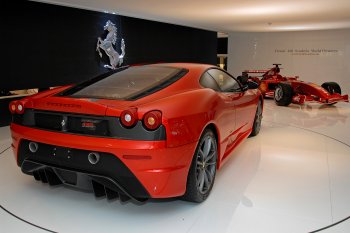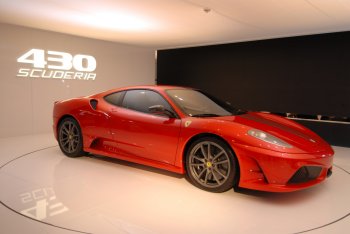|
The
Australian International Motor Show (11-21 October 2007)
will feature a number of environmental cars, but not
many show visitors, looking for a car to answer the
complex questions of using less fuel and lowing
emissions would turn to the Ferrari stand, the home of a
range of exceptional super cars. And yet, while Ferrari
is displaying its fastest ever production model, the new
Ferrari 430 Scuderia, the same car also has the lowest
fuel consumption and the lowest emissions of any model
in the Ferrari range, a seeming contradiction in terms.
But the Ferrari 430 Scuderia is living proof that the
advanced technology in all areas that makes it Ferrari’s
ultimate supercar, is also technology that can and will
make all cars use less fuel and reduce emissions in the
future.
“With such
beautiful styling providing the visible promise of
outstanding levels of performance, its all too easy to
forget that every Ferrari is also a technical tour de
force and that Ferrari is debuting technology that will,
one day, become much more widely available,” says Kevin
Wall, General Manager for Ferrari in Australia and New
Zealand. “While today’s Ferraris may seem just a dream
to many, a closer look will reveal technology that will,
one day make many cars safer, cleaner and – of course –
faster.”
Looking at
a Ferrari that can top 320 km/h, environmental
compatibility may not be the first thing that springs to
mind. Yet, to achieve the remarkable performance offered
by every Ferrari, the engines have to be extremely
efficient, extracting every possible amount of power
from the fuel provided, while meeting the latest
emission standards. Technology developed for Ferraris
cutting-edge V8 and V12 engines will make tomorrow’s
engines cleaner and more efficient.
With the
new 430 Scuderia, Ferrari’s engine designers have
developed a new ‘breathing’ system for the engine that
releases more power and torque from the engine, in turn
making it more efficient. Therefore, it uses less fuel
and cuts emissions. So although the 430 Scuderia is now
as fast around the Ferrari test track as the lavishly
powerful limited-production V12 Ferrari Enzo, fuel
consumption is cut from 18.3 l/100 km for the normal
F430 Coupe to 15.7 l/100 km for the Scuderia and carbon
dioxide emissions are down from 420 to 360 g/km.
Gearbox
technology debuted by Ferrari first on the race track
and then in road cars, the sequential or robotized
manual gearbox, has already transferred to mainstream
cars and it is making those cars more economical and it
cuts emissions. This is because a robotized manual not
only provides better than manual transmission
performance, as it slashes gearchange time to just 60
milliseconds in case of the 430 Scuderia and its new
F1-SuperFast2 transmission, it also removes fuel use and emissions
during gear changes to effectively nil. It is no
coincidence that two of the most economical conventional
cars available on the market use robotised manual
transmissions.
Weight is not just the enemy of
performance. The heavier a car is, the more fuel is used to move it and the more
emissions are produced. Working with Alcoa, Ferrari has pioneered aluminium
construction, making its cars – all of which are aluminium – lighter and more
fuel efficient. Aluminium is also easier to recycle – not that Ferrari expects
any of its products to be recycled any time soon – but this is, again,
technology that is transferring to the mass market.
|
 |
|
Looking at a Ferrari sportscar that can top 320
km/h, environmental compatibility may not be the
first thing that springs to mind. |
|
|
 |
|
The Australian International Motor Show will feature
a number of environmental cars, but not many show
visitors, looking for a car to using less fuel and
lowing emissions would turn to the Ferrari stand. |
|
|
The Ferrari 430 Scuderia takes this one step further. Not
only does it use aluminium and carbon fibre, which is very
light and very strong, it also pioneers the use of a new
material, RTM, which is almost as light and strong as carbon
fibre, but is considerably lower in cost and provides an
obvious transfer prospect for reducing weight in all cars.
From speeds as low as 60 km/h a car can be using more power
to move air out of the way than it does to make it go down
the road, so anything that can be done to cut drag will
boost performance and save fuel, while cutting emissions.
But at the same time, a car has to be stable in all
conditions, get cooling air to the engine.
Ferrari has,
once again, pioneered aerodynamic design. For example, the
‘flying buttresses’ behind the doors of 599 GTB Fiorano not
only look good, they provide up to 100 kg of down force to
keep the 599 glued to road, they also direct the airflow for
directional stability in cross winds, yet they cause a
fraction of the drag compared to conventional wings and
spoilers on cars. But the Ferrari 430 Scuderia goes one
remarkable step further. The industry-leading aerodynamic
experts at Ferrari have achieved the seemingly impossible,
by lifting the new car’s downforce by up to 30 kg with no
increase what so ever in fuel-sapping and
emissions-increasing drag.
Electronic
Stability Control is the buzz word in safety circles, with
calls for it to be made standard on all cars; such is its
massive effect on safety. Needless to say, this is another
technological area pioneered by Ferrari on and off the race
track. While the systems used in conventional cars control
just the brakes and the throttle, in the Ferraris at the
Australian International Motor Show it’s possible to see the
future of the remarkable life-saving technology.
The CST and
E-Diff systems mean for all their huge performance
potential, every Ferrari can be driven in every day
conditions of rain and even snow and ice with ease and
safety. In addition to brake and throttle control, the CST
and E-Diff systems add the ability to change engine and
steering response, brake pedal loads and do it at light
speed, producing a new level of safety and control in
difficult conditions. The 430 Scuderia takes these systems
to a new level with full integration of the traction control
and E-Diff to provide a new level of control and response.
The Ferrari 599 GTB Fiorano has added to this technological
armoury SCM Magnetorheological Suspension that can instantly
change the response of the suspension to meet different road
and driving conditions. This means a comfortable, supple
ride, when required, yet the ability to instantly adjust to
the needs of super car performance.
“A visit to
the Ferrari stand is not just a chance to dream about owning
the ultimate super car,” says Mr Wall. “It is also an
opportunity to glimpse the future of all cars with
technology that will make them safer, cleaner and faster.
Thus, a Ferrari truly is a super car in every sense of the
word!"
|
|
|
|